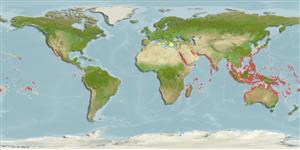Common names from other countries
Environment: milieu / climate zone / depth range / distribution range
Ecologia
; intervalo de profundidade 0 - 20 m (Ref. 348). Tropical
Indo-West Pacific and the Mediterranean: from East Africa, to Melanesia; north to South China and Taiwan Province of China and south to Indonesia; south and eastern parts of the Mediterranean. Tropical to subtropical climates.
Length at first maturity / Tamanho / Peso / Idade
Maturity: Lm ? range ? - ? cm Max length : 12.0 cm SHL macho/indeterminado; (Ref. 348); common length : 8.0 cm macho/indeterminado; (Ref. 348)
Locally collected at low tide by coastal people when abundant (Ref. 348).
Life cycle and mating behavior
Maturidade | Reprodução | Desova | Ovos | Fecundidade | Larvas
Members of the class Bivalvia are mostly gonochoric, some are protandric hermaphrodites. Life cycle: Embryos develop into free-swimming trocophore larvae, succeeded by the bivalve veliger, resembling a miniature clam.
Poutiers, J.M. 1998. (Ref. 348)
Status na Lista Vermelha da IUCN (Ref. 130435: Version 2024-1)
Status no CITES (Ref. 108899)
Not Evaluated
Not Evaluated
Uso pelos humanos
| FishSource |
Ferramentas
Mais informação
Idade/Tamanho
Crescimento
Comprimento-peso
Comprimento-comprimento
Morfologia
Larvas
Abundância
Fontes da internet
Estimates based on models
Preferred temperature
(Ref.
115969): 22.1 - 29.3, mean 28.2 (based on 4092 cells).
Vulnerabilidade
Low vulnerability (10 of 100).
Categoria de preço
Unknown.
